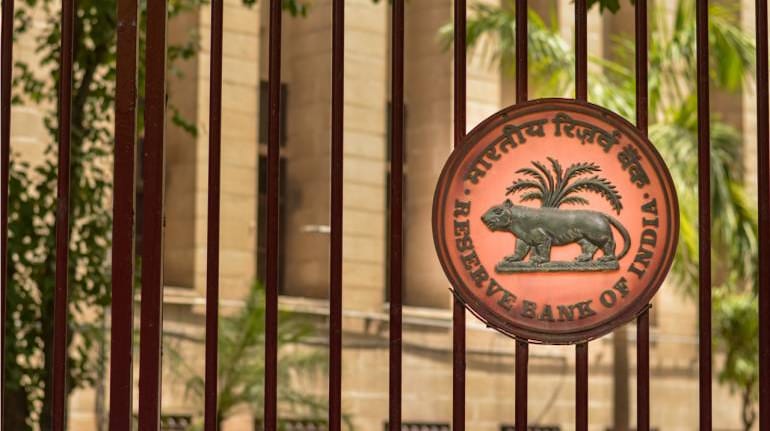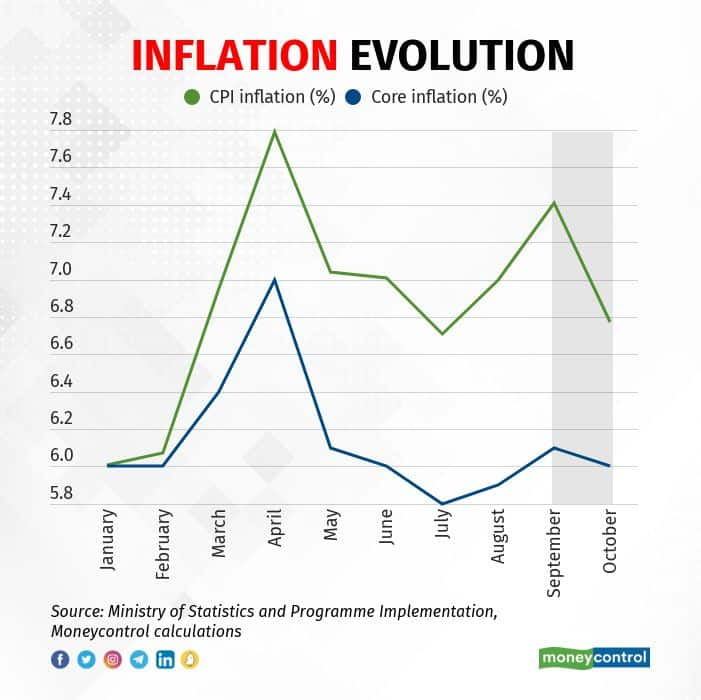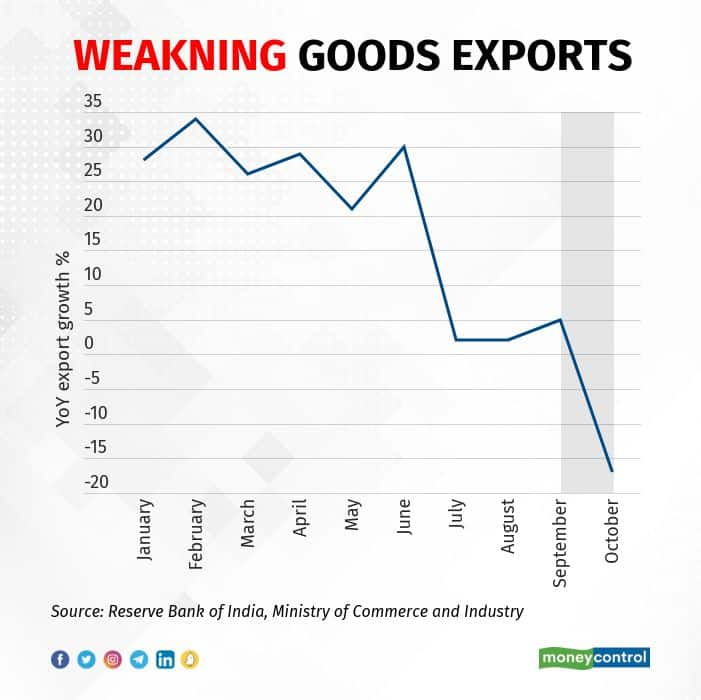



The Reserve Bank of India's Monetary Policy Committee started its three-day meeting on December 5. Headed by Governor Shaktikanta Das, the committee's decision is scheduled to be announced at 10:00 am on December 7.
The MPC is widely expected to raise the policy repo rate for the fifth time in eight months and take the key rate beyond the 6-percent mark. Most economists see the repo rate being raised by 35 basis points to 6.25 percent.
One basis point is one-hundredth of a percentage point.
While voting on the interest rate decision, the committee's members will examine a range of data to assess the economy. Moneycontrol takes a closer look at the movement of key economic indicators since the MPC met on September 28-30, when it voted to increase the repo rate by 50 basis points to 5.9 percent.
It goes without saying that this list of indicators is not exhaustive, but they are crucial in representing the state of the Indian economy.
InflationThe RBI has failed to meet its inflation mandate, with the MPC subsequently meeting in early November to discuss the report the central bank had to submit to the government. Inflation continues to be above the 6 percent upper bound of the RBI's tolerance range despite a favourable base effect dragging it down to a three-month low of 6.77 percent in October.

The latest Consumer Price Index (CPI) inflation print is 23 basis points lower than the August figure. But it is expected to move down significantly only in the first quarter of 2023, with the RBI projecting average inflation at 5.8 percent.
Core inflation, that doesn't include food and fuel items, meanwhile, remains sticky at around 6 percent.
GrowthIf things are set to become easier for the RBI's primary mandate, the outlook for the other objective – economic growth – has gotten darker.

As per data released on November 30, India's gross domestic product (GDP) grew 6.3 percent in July-September, in line with the consensus estimate of 6.3 percent, but less than half the April-June figure of 13.5 percent.
Growth is expected to moderate further in the second half of FY23 to close to 4 percent – but not only due to the fading of the favourable base effect.
ExportsThe tightening of monetary policy globally is dragging growth down rapidly, with Pierre-Olivier Gourinchas, the International Monetary Fund's (IMF) chief economist, warning in late October that "the worst is yet to come and, for many people, 2023 will feel like a recession".

India has already started to feel the weakening of external demand, with merchandise exports shrinking by 17 percent and falling below $30 billion in October – the first time either has happened since February 2021.
According to economists, the links between the domestic capex cycle and the global cycle as well as the domestic manufacturing sector and external demand mean weak exports will weigh on India's growth.
Credit growthWhile the external demand and its possible impact will be giving policymakers sleepless nights, they have been taking solace in the impressive growth in domestic bank credit.

As per the latest data, year-on-year growth in Indian banks' non-food credit eased slightly to 16.4 percent as on November 18 from 17.1 percent the previous month. It was as recently as March that loan growth was in single digits.
"It (credit growth) is not just concentrated in one sector. Credit to MSMEs (Micro, Small, and Medium Enterprises) is particularly strong and that is gratifying… Clearly, there is a very strong momentum in credit growth and the demand from credit coming from all sectors points to continued economic momentum and growth continuing," Chief Economic Adviser V Anantha Nageswaran told reporters on November 30.
Lending ratesThe demand for loans has increased even in a rising interest-rate environment.

As per latest data, the weighted average lending rate on outstanding loans has increased by more than 60 basis points since April. The increase for fresh loans is an even greater 117 basis points over the same period, reflecting the rapid tightening of monetary policy by the MPC.
Oil prices
Global oil prices have been edging down, with the average price of India's crude oil basket in November down nearly 25 percent from its peak in June. However, they remained elevated at over $85 per barrel, although the early days of December have seen a pullback from that level, providing what can only be further good news on the inflation front even if the trade deficit remains uncomfortably high.
Exchange rateThe RBI and members of the MPC have been vehement in rejecting the rupee's exchange rate as a determinant of monetary policy. What the central bank has done instead is to utilise its foreign exchange reserves to reduce volatility.

While the tide may not have turned for the Indian currency, some of the pressure certainly did ease in November after a torrid October thanks to US inflation cooling to 7.7 percent from 8.2 percent in September.
Interest rate differentialThe difference between the interest rates prevailing in India and developed countries such as the US is a determinant of inflows into India. And this difference has been narrowing in recent months.
"If the MPC were to pause at this stage, holding the repo rate at 5.9 percent, then the interest differential would fall to just 90 basis points, assuming the Fed Funds rate rises to 5 percent next year," said Kaushik Das, Deutsche Bank's chief economist for India.
"We think the interest differential should at least stay above 100 basis points, which fits in with our view of the RBI hiking the repo rate by 35 basis points (on December 7)," Das added.

If one were to compare the yields on government bonds of similar maturity, the differential fell from nearly 500 basis points in early March to 333 basis points on November 1.
Discover the latest Business News, Sensex, and Nifty updates. Obtain Personal Finance insights, tax queries, and expert opinions on Moneycontrol or download the Moneycontrol App to stay updated!
Find the best of Al News in one place, specially curated for you every weekend.
Stay on top of the latest tech trends and biggest startup news.